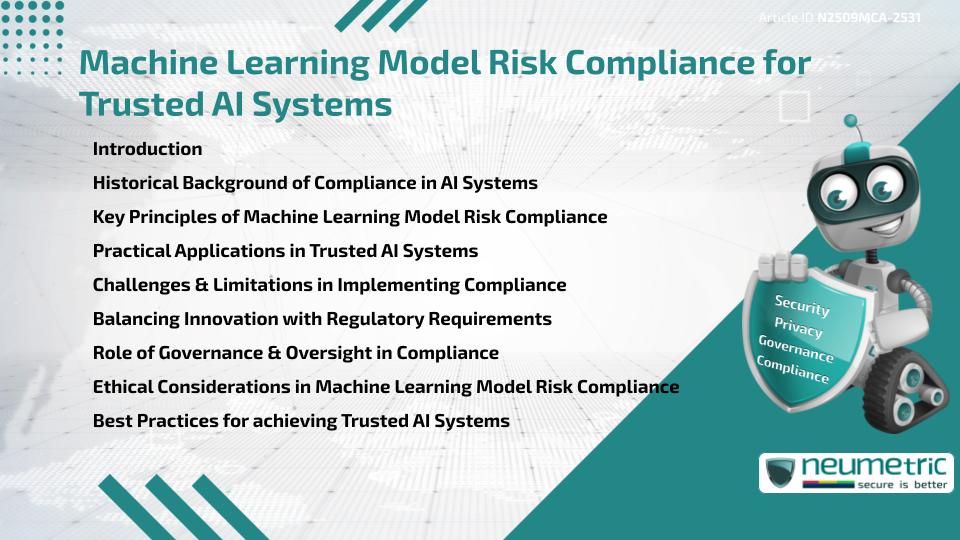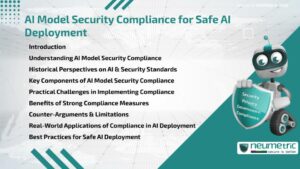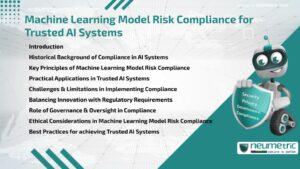Table of Contents
ToggleIntroduction
Machine Learning Model Risk Compliance plays a central role in ensuring that trusted AI Systems remain Ethical, Reliable & Transparent. It addresses Risks such as Data Bias, lack of Explainability & Regulatory gaps while providing a structured Framework for Governance & oversight. From protecting Consumers to safeguarding Organisations against legal liabilities, Machine Learning model Risk Compliance is a cornerstone of responsible AI adoption. This article explores the history, principles, challenges & Best Practices that shape Compliance in trusted AI Systems.
Historical Background of Compliance in AI Systems
The concept of Compliance in technology is not new. Financial institutions first introduced model Risk Management frameworks in the early 2000s to address inaccuracies in Credit scoring & Risk prediction models. These early practices laid the groundwork for today’s Machine Learning model Risk Compliance. The surge in AI adoption brought new Risks, such as Algorithmic bias & opaque Decision-making, which required more comprehensive approaches. Regulatory efforts like the European Union’s AI Act & global guidelines from the OECD reflect the growing importance of Compliance in building trusted AI Systems.
Key Principles of Machine Learning Model Risk Compliance
Machine Learning Model Risk Compliance rests on a few key principles:
- Transparency: AI Systems must allow Stakeholders to understand how models make decisions.
- Fairness: Models should avoid discriminatory patterns against individuals or groups.
- Accountability: Organisations must establish clear responsibilities for model development, monitoring & deployment.
- Robustness: Models must perform consistently across different environments & remain resilient to adversarial attacks.
Together, these principles create a foundation for building AI Systems that earn User trust while satisfying regulatory demands.
Practical Applications in Trusted AI Systems
Machine Learning Model Risk Compliance has practical applications across industries:
- Healthcare: Ensures diagnostic tools respect Privacy & provide equitable treatment recommendations.
- Finance: Reduces Risks of unfair lending practices & Regulatory breaches.
- Transportation: Supports safe & explainable decision-making in autonomous vehicles.
- Public Sector: Promotes Accountability in Government decision-making systems.
In each case, Compliance frameworks serve as guardrails, ensuring that innovation does not undermine fairness or safety.
Challenges & Limitations in Implementing Compliance
Despite its benefits, implementing Machine Learning model Risk Compliance presents challenges. Monitoring constantly evolving models requires ongoing resources. Bias mitigation is complex because datasets often reflect historical inequalities. Moreover, global Organisations must navigate varying regional standards, such as the NIST AI Risk Management Framework in the United States & ISO standards worldwide. These factors make Compliance both costly & time-consuming.
Balancing Innovation with Regulatory Requirements
One common concern is whether strict compliance stifles innovation. Overly rigid rules may slow down AI deployment or discourage experimentation. However, many experts argue that clear guidelines actually enable innovation by reducing uncertainty. Just as building codes ensure safe construction without halting architecture, Machine Learning model Risk Compliance allows Organisations to innovate confidently within safe boundaries.
Role of Governance & Oversight in Compliance
Strong Governance structures are essential for successful Compliance. Oversight bodies, including Risk committees & Compliance officers, ensure that AI Models meet both internal Policies & external Regulations. Independent Audits & Third Party validations further enhance Accountability. Without Governance, even the most advanced technical safeguards may fail to prevent harmful outcomes.
Ethical Considerations in Machine Learning Model Risk Compliance
Beyond Regulatory & Operational concerns, Ethical issues are central to Machine Learning model Risk Compliance. Organisations must ensure that models respect human dignity, avoid reinforcing harmful stereotypes & protect individual rights. Ethical Compliance aligns with broader values such as social justice & consumer protection, making it indispensable for trusted AI Systems.
Best Practices for achieving Trusted AI Systems
Achieving effective Machine Learning model Risk Compliance requires several Best Practices:
- Establishing interdisciplinary teams that include technologists, ethicists & legal experts.
- Conducting regular Audits & stress tests on AI Models.
- Providing clear documentation for Stakeholders at all levels.
- Engaging with external Regulators & Industry groups to stay aligned with evolving standards.
These practices not only reduce Risks but also enhance confidence among Users, Investors & Regulators.
Takeaways
- Machine Learning Model Risk Compliance ensures Fairness, Transparency & Accountability in trusted AI Systems.
- Historical lessons from Finance & global Regulations shaped today’s Compliance frameworks.
- Challenges such as resource demands & regulatory diversity require careful management.
- Governance, Ethics & Best Practices strengthen Compliance & foster User trust.
FAQ
What is Machine Learning model Risk Compliance?
It is the Framework of principles, practices & regulations that ensure AI Models operate transparently, fairly & responsibly.
Why is Machine Learning model Risk Compliance important?
It helps prevent harm, reduces Bias, protects Consumers & aligns AI Systems with Legal & Ethical Standards.
What industries benefit most from Machine Learning model Risk Compliance?
Healthcare, Finance, Transportation & Government sectors gain the most by reducing Risks & ensuring Trust.
Does Compliance slow down AI innovation?
Not necessarily. Compliance can provide clarity, reduce uncertainty & promote safe innovation within defined boundaries.
How does Governance support Machine Learning model Risk Compliance?
Governance ensures proper Oversight, Accountability & independent Validation of AI Systems.
What are the ethical aspects of Machine Learning model Risk Compliance?
Ethical aspects include fairness, protection of individual rights & the avoidance of discriminatory practices.
How can Organisations achieve trusted AI Systems?
They can achieve this by applying Best Practices such as Audits, Documentation, Interdisciplinary collaboration & Regulatory engagement.
Need help for Security, Privacy, Governance & VAPT?
Neumetric provides organisations the necessary help to achieve their Cybersecurity, Compliance, Governance, Privacy, Certifications & Pentesting needs.
Organisations & Businesses, specifically those which provide SaaS & AI Solutions in the Fintech, BFSI & other regulated sectors, usually need a Cybersecurity Partner for meeting & maintaining the ongoing Security & Privacy needs & requirements of their Enterprise Clients & Privacy conscious Customers.
SOC 2, ISO 27001, ISO 42001, NIST, HIPAA, HECVAT, EU GDPR are some of the Frameworks that are served by Fusion – a SaaS, multimodular, multitenant, centralised, automated, Cybersecurity & Compliance Management system.
Neumetric also provides Expert Services for technical security which covers VAPT for Web Applications, APIs, iOS & Android Mobile Apps, Security Testing for AWS & other Cloud Environments & Cloud Infrastructure & other similar scopes.
Reach out to us by Email or filling out the Contact Form…





